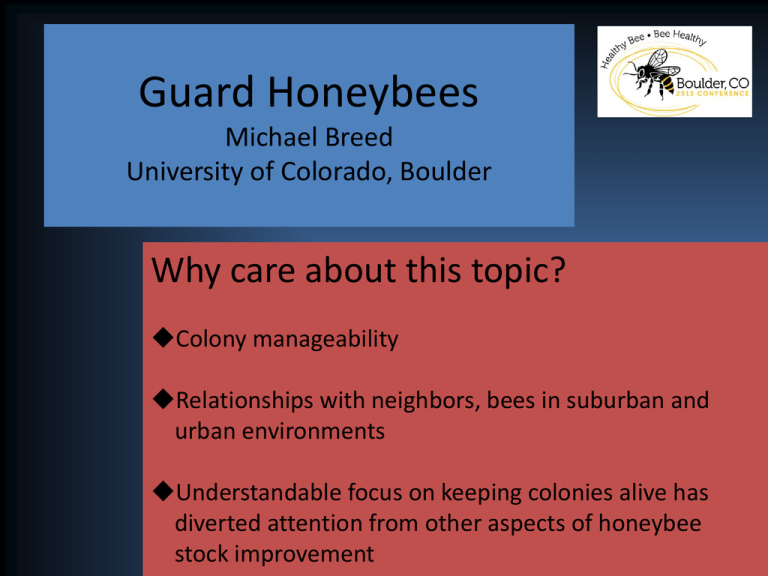Breed WAS 2015 presentation
advertisement

Guard Honeybees Michael Breed University of Colorado, Boulder Why care about this topic? Colony manageability Relationships with neighbors, bees in suburban and urban environments Understandable focus on keeping colonies alive has diverted attention from other aspects of honeybee stock improvement Basic organization of honeybee colony defense Other bee, small animal trying to enter nest Single or small group of middle aged bees respond Large predator, mammal or bird trying to enter nest Many older bees respond Stinging & Alarm Pheromone Guards versus soldiers Variation among bees in behavior—scheme through life http://bees potter.mste. illinois.edu/ topics/socia l/ Guard bees—Age and Persistence http://www.thehoneygatherers.com/html/photolibrary1.html Moore, Breed and Moor, Animal Behaviour 35:1159-1167 (1987 Variation among colonies in defensiveness Differences among strains/ecotypes Africanized versus European bees Variation among colonies within strain Can be substantial—more likely due to genes rather than experience How do guards function? Identify threats based on motion and proximity Discriminate nestmates from nonnestmates Respond to other species, such as yellowjackets Persistence and colony defensive responses? Chasers and guards Some bees fire out of the hive and chase intruders in the area around the hive These are guards Post stinging behavior Chasers have often already stung Bee has continued defensive value in intimidation even after it has stung Seasonal changes Woyke 1992 Repeated disturbances Does defensiveness increase? Do bees identify individual causes of disturbances and respond more to those? Genetic studies of defensiveness Strong genetic basis for differences in defensiveness among colonies and strains Shows promise for selection of stock for manageability and compatibility with urban beekeeping Work done by Page, Hunt and their colleagues Defensiveness/foraging returns/hygienic behavior correlations Degree of linkage among traits affects how easily we can select for one of them African bees have faster development, perhaps explaining the large number of soldiers and higher defensiveness Defensiveness/foraging returns/hygienic behavior correlations Defensiveness/foraging tradeoff might exist? Tradeoffs for hygienic behavior? But also general activity could increase both traits—slothful bees are neither very defensive or good foragers Is it worthwhile trying to select lines of bees for defensive characteristics? This is a good question for the future Urban compatibility is a key element Manageability is also important, particularly if absconding can be sorted out from desirable traits Questions?





